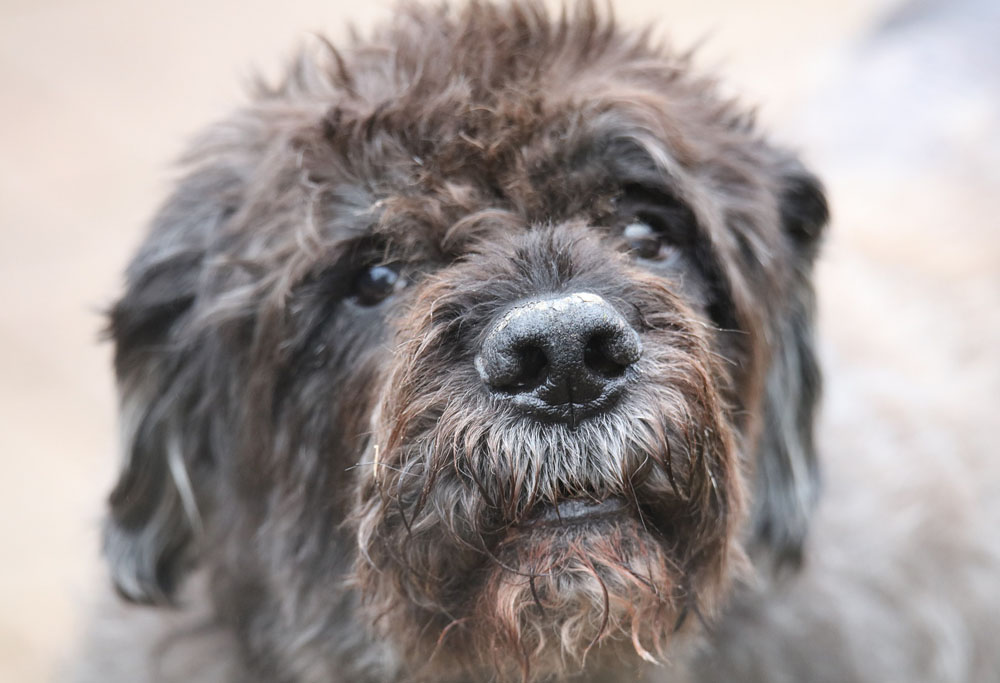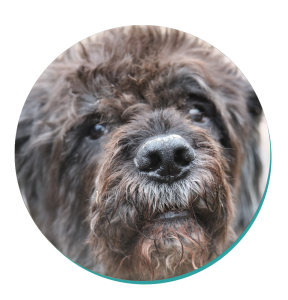Refer back to your high school French class for proper pronunciation of this breed: the Bouvier des Flandres! In this Dog Breed Corner, we’ll learn about this dog’s history, trainability, health, and more. And for a flavoursome Flandres-friendly dog meal plan, sign them up to Mad Paws Dinner Bowl!
Quick Facts ✔
Height – 56 – 71cm
Weight – 30 – 45kg
Lifespan – 10 – 12 years
Country of origin – Belgium
Breed type – Herding
- Active families
- Homes without small animals
- Homes with plenty of outdoor space
Bouvier des Flandres Breed History ♜
At a glance, you might assume that this bearded doggo was bred for the show ring. And with that full face of hair and proud stance, it’s a fair assumption. In reality, though, the Bouvier des Flandres comes from rather humble beginnings.
The Bouvier des Flandres’s history takes us back to the Middle Ages. There, they began their life in a region called Flandres (often spelled Flanders in English). Later, this area would become a bustling centre of industry and trade. When the Bouvier des Flandres arrived on the scene, however, Flanders was largely agricultural. Farmers here needed a hardy, strong cow herding dog—bouvier in French means cowherd—so they enlisted the help of a few different dog breeds. Irish Wolfhounds, Scottish Deerhounds, some sheepdog breeds, and other large working dogs with rough coats all likely featured in the development of this Bouvier.
For many generations, the Bouvier des Flandres didn’t adhere to any particular look or size. Instead, farmers would select the dog with the best working ability. In particular, they needed one dog who could do it all: herd the cattle, guard the farmhouse, and pull the wagon of fresh dairy-based goods into town. Some of these burly doggos even turned millstones, a job usually reserved for larger animals like donkeys or mules!
As the Bouvier des Flandres gradually became one of the most valuable additions to any farm in the region, fans of the dog went about standardising the breed. This caused some controversy, as there was much variation between dogs. As such, quite a few arguments abounded over whether the Bouvier was French or Belgian. It wasn’t until the early 20th century that breed experts ironed out those details. Once they agreed upon a breed standard, the Bouvier des Flandres looked to be on the path towards international success.
That is, until the outbreak of World War I, and later World War II. It was a difficult era for the breed, given that their homeland was now a dangerous battlefield. Indeed, without the work of international dog fanciers and the Belgian police, who decided to bring the breed back as police dogs in peacetime, this breed may not have survived.
Luckily, the breed did make a full recovery, and now graces homes all over the world. They’ve joined police forces everywhere from France to Canada, and in the United States, they’ve added the title of Therapy Dog. In Australia, you’re more likely to see them living a peaceful family life than flaunting their impressive cow herding skills.
Bouvier des Flandres Personality Traits ★
After learning more about this doggo’s history, you might find that their personality is reminiscent of life on a farm.
These dogs, for instance, are highly intelligent and confident. They take direction easily but won’t feel anxious without guidance from their Owners. While they are easy-going and calm, don’t expect this dog to relax. Instead, they’ve always got an eye on what’s going on around them; they’ll always be ready to spring into action if they feel their humans need their services.
As watchdogs, they excel. They’ve developed guarding skills from generations of patrolling farms and protecting the herd from wolves and other predators. And with a booming, somewhat intimidating bark, they’re likely to ward off any intruders.
A Bouvier’s temperament with other animals will depend largely on how they were raised. A true farm dog will have plenty of socialisation around other dogs and livestock, making them a friendly part of the pack. But without early exposure to positive interactions with other dogs, they can become aggressive.
And, no matter how successful their early socialisation, these dogs never seem to give up their high prey drive. Smaller animals like cats and rabbits may not be safe around a dog like the Bouvier des Flandres, unless they’ve been trained since puppyhood.
Children, however, are another matter. A family dog at heart, the Bouvier is a loyal companion and will show a great deal of patience with even small kids. That said, their size can lead to accidental toppling over. And, their inherent herding instinct might lead this protective pup to nudge and even nip children. It’s well-intentioned behaviour, but should be corrected in a household with children.
Overall, the Bouvier des Flandres is loyal, intelligent, alert, and engaged. They love spending time with their humans, and consider protecting their pack their number one priority. With good socialisation, they’ll get along well with humans, animals, and other dogs.
Trainability and Training Tips
Even if you’ve got the most cuddly and laid-back Bouvier, training is still absolutely crucial. After all, this is a large doggo with a huge bark. Not only is that intimidating, but without proper training, it can be dangerous as well. So start early, and make sure that basic obedience is a priority.
Luckily, despite their self-assuredness, you’ll find that the Bouvier des Flandres isn’t an overly stubborn breed. And because they are so intelligent and people-oriented, training is easy and enjoyable.
Once you’ve mastered the basics, you can provide this pup with training sessions that will satisfy their work drive. These dogs excel at specific tasks, such as agility training or scent tracking. Not only will these activities provide some much-needed mental stimulation for a smart pup like the Bouvier, but the extra training is also a great way to bond with them.
Even without an actual job to do, training sessions can scratch the Bouvier’s itch to work. Teach them how to dance, have them pull the wagon of groceries home from the store, or teach them how to place their leash back on the hook by the door after a walk. The more creative you are with training, the more amazed you’ll be at this pupper’s trainability!
Bouvier des Flandres Exercise Needs & Living Conditions ⌂
Another advantage to regularly training the Bouvier is that it will help to address their high exercise needs. But even daily training sessions won’t be enough for these energetic canines! Without the working atmosphere, modern-day Bouvier Owners have to make exercise a priority.
In a Bouvier des Flandres’ perfect world, they’d get at least an hour of rigorous play or exercise per day, plus training, plus maybe a walk to wind down. It’s a bit more than most families can manage alone, so the help of a Dog Walker can work wonders.
And, if you’re looking for a shortcut to tire out the Bouvier, here’s a (not so) secret: these doggos love water! Get them to the beach or a lake, and they’ll splash around until they’re tired enough to sleep on the way home.
When it comes to living conditions, these dogs enjoy a bit of outdoor space that they can look after. This isn’t exactly an outdoor dog, but they do like the opportunity to patrol a backyard and watch over their territory. That said, keep an eye out that they don’t stick their snout where they might come across wildlife, because these puppers will jump into action. And, if they’re going to be traipsing through long grasses, give them a good look-over for ticks and other parasites.
Even with a large backyard, the Bouvier won’t appreciate a cramped indoor space. While these dogs are more graceful than others of their size, they will need enough space to move around comfortably.
And while we’ve already mentioned the large bark, it’s worth noting in terms of living conditions as well. In an apartment complex or busy area, that guard dog bark may get you in trouble with your neighbours. So, it might be a good idea to train them to respond to a quiet command, or find a way to quell their watchdog tendencies.
Bouvier des Flandres Grooming ✄
One of the most distinctive features of a Bouvier des Flandres is that thick, rough coat and signature beard. And while the good news is that these dogs don’t shed as much as others, this breed does have a few grooming needs.
In particular, that double coat will need to be brushed a couple of times per week to remove tangles and debris. You may find yourself brushing even more frequently if your Bouvier loves diving headfirst into fields and dense underbrush.
Regular bathing is also a necessity with this breed. Due to that course outer coat, skipping this step will give your Bouvier a lackluster, unkempt look. So, run the bath about once per month (no more, or else you’ll risk skin issues) to keep that coat clean and beautiful.
Alternatively, you can follow the lead of many Bouvier des Flandres Owners and take them to the groomers. There, your dog’s coat can be properly cleaned and clipped into the classic Bouvier shape. It’s a tricky haircut to master, but the important part is that the hair around the eyes and mouth is trimmed for your dog’s sight and comfort.
Beyond the somewhat high-maintenance coat needs, you’ll want to make sure to trim your dog’s nails and clean their teeth regularly.
Bouvier des Flandres Health +
Fortunately, the Bouvier des Flandres has been spared from too many inherited diseases. Sadly, hip and elbow dysplasia, as well as some eye conditions like glaucoma and cataracts, can develop. However, they’re not as common as in many other large breeds.
That said, barrel-chested dogs like the Bouvier can suffer from bloat, so special precautions may help to prevent this life-threatening condition. Take a look at our tips on How to Stop Your Dog Eating Too Fast to help them slow down mealtimes and lower the risk of bloat.
Speaking of mealtimes, this is a highly food-motivated breed, which can make managing their weight a challenge. Bouvier Owners may want to limit the treats, keep the kitchen counters clear, and hide the food bag away from snooping snouts. Even with these precautions, regular exercise and a healthy diet are a must.
Fun Fact about the Bouvier des Flandres ♥
We love a good doggie nickname, and the Bouvier des Flandres has one to remember. Ever since the beginning of the breed, the Bouvier has sported the nickname, des preux vuilbaard, meaning “dirty beard.”
While it may not be any easier for the non-French speaker to pronounce, this nickname is perfect for the Bouvier. Because of that scruffy face and their tendency to follow their curiosity face-first, the Bouvier beard is notorious for picking up dirt, water, mud, twigs, and any number of other things. Owners of this breed aren’t likely to leave the house without a towel to wipe that vuilbaard after every adventure.
Final Thoughts on the Bouvier des Flandres
On first inspection, you might find the Bouvier des Flandres to be a regal, graceful, and proud doggo. But the truth is, they’ve always been a salt-of-the-earth working companion.
Highly energetic and prone to some behavioural issues, it’s key that this dog has plenty of outlets. As such, the help of a Dog Walker can be a huge advantage in managing this dog’s exercise needs.
And, while generally healthy, these dogs will overindulge if allowed. Mad Paws Dinner Bowl can help Owners lay out an appropriate meal plan, but limiting treats and Bouvier-proofing the kitchen may also be necessary.
Overall, these dogs are intelligent, alert, and endlessly loyal. The Bouvier des Flandres is versatile enough for any farm task while also being quite content to live out their best lives as your faithful family dog!


